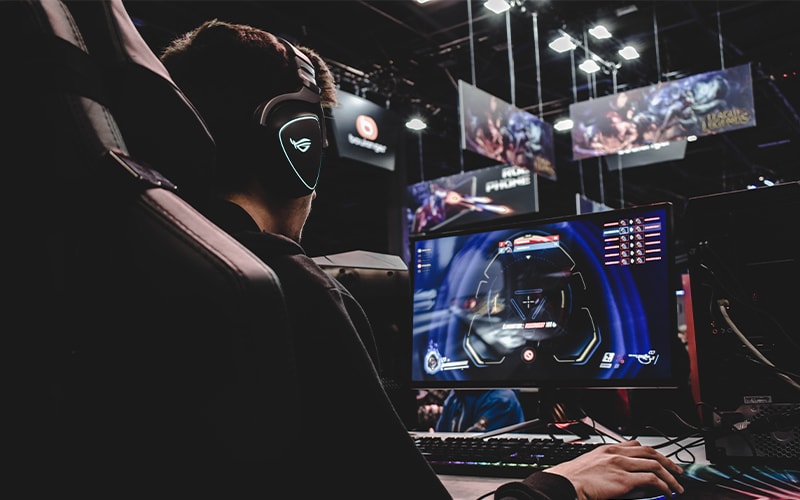What Marketers Need to Know about E-Sports

The competitive gaming industry, commonly referred to as e-sports, has already caught up to real-life professional sports in terms of media attention, viewership, revenue, and even prize money. Just like any other sport, the rise of e-sports is powered by their star athletes, online personalities, and teams which have attracted more consumers to gain interest.
The drastic increases in revenue can be attributed to the rising talent as well, but more so to the brands that have welcomed the opportunity to invest into this growing and highly engaged audience. Newzoo predicts that by 2021, e-sports will generate more than $1.65 billion in total revenue, with $1.39 billion coming from brand investments.
Alongside revenue growth, one of the most drastic increases in e-sports over the past several years is the amount of time that people are spending watching videos and online streams. In 2012, people were spending roughly 1.3 billion hours watching e-sports videos. This increased slightly to 2.4 billion hours in 2013. Last year in 2018, people watched 6.6 billion hours of e-sports videos worldwide. This is an increase of almost 1 billion hours each year.
With these reported increases in revenue potential and viewership, it’s no mystery as to why brands are investing into the competitive gaming community. If you are beginning to explore the advertising opportunities within e-sports, there are a few things you should keep in mind:
Understand the Culture & Audience
The e-sports audience is full of young, tech-savvy consumers. They crave authentic brand stories and don’t want to be sold to. It’s imperative that your brand find creative ways to get in front of this millennial and Gen-Z filled audience.
According to Activate, 62% of US e-sports viewers are aged 18-34, and 58% have a positive attitude toward brand involvement in eSports, per Nielsen. Business Insider suggests Gen-Zers are more receptive to nontraditional sports, like e-sports, than traditional sports — 56% of US Gen Z men (aged 13-21) said nontraditional sports are “relevant to my generation.”
In addition to understanding the end consumer, brands must also immerse themselves in the platforms that are driving this industry forward. Gaining first-hand experience on channels such as Twitch and YouTube will help you develop a strategy that will resonate with streamers and their fans. You can also keep an eye on new or growing platforms such as Mixer, the new Microsoft-owned network that recently signed the world’s most influential gamer, Ninja.
Partnerships & Product Integration
Whether or not your product is directly related to video games, there is plenty of opportunity to get involved. E-sports fans are more likely to reward brands that make an investment into the leagues, teams, and players. Brands who are seen as exploitive and only in it for a short-term gain will be punished.
“What gamers care about is altruism, and they want to see the brands doing something that benefits the space, not just the brand,” – Nathan Lindberg, Director of Global eSports Sponsorships at Twitch
Once you explore the individuals and organizations that are leading the charge in e-sports, find mutually beneficial ways to form partnerships and collaborate:
- Tournament Sponsors
- Player & Team Sponsors
- Content Collaboration
- Digital Streaming Ads
- Influencer Campaigns
Influencer Marketing
Influencer marketing has become one of the most popular forms of advertising for direct-to-consumer brands. The unique advantage of leveraging e-sports influencers is that their profession is primarily built on video streaming and online viewership. Most of these e-sports athletes are natural content creators, and in many cases they have teams creating content for them as well.
The one caveat that comes with influencer marketing is that it is difficult to come off as authentic. A solution to this issue is to build relationships with micro-influencers. Instead of going for the streamer with the most views, find an upcoming e-sports athlete that has a smaller, more engaged audience. Not only can brands cut through the noise by accessing these smaller audiences, but they can help support competitive gamers in their journey and help them grow.
In the end, Influencers are a powerful way to increase awareness for your brand and build loyalty with end consumers. Focus on forming healthy relationships with content creators that have the potential to be long-term partners.
Conclusion
There are a variety of possibilities for brands to get involved with e-sports and ride the wave of a growing industry. In 2019, it’s crucial that marketers familiarize themselves with e-sports and identify opportunities before the arena becomes too saturated.
If you’re looking for more guidance in this rapidly evolving space, our Martin Sport team can help! Drop Brian an email to set up a meeting.